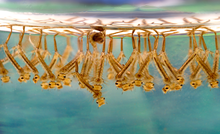Mosquito larva
Due to formal or content deficiencies in the quality assurance biology in the section "Insects" for improvement, this article has been entered. This is done in order to bring the quality of the biology articles to an acceptable level. Please help improve this article! Articles that are not significantly improved can be deleted if necessary.
Read the more detailed information in the minimum requirements for biology articles .
Mosquito larvae are a development stage of the insect subordination of mosquitoes from the order of Diptera (Diptera).
The larvae of the individual families have very different ways of life: Many live in moist areas near the ground, others on plants; the best known and most conspicuous is certainly the aquatic way of life. The diet is also very different. Many species overwinter in the larval stage.
The body is usually built like a worm and, in contrast to the fly larvae ( maggots ), usually has a head capsule. Foot-like appendages have only ground-dwelling forms, legs are missing. The water-dwelling species take in air through a tuft of hair at the end of the abdomen, on which the animal hangs under the surface due to the adhesive force of the water.
Mosquito larvae as fish food
Water-dwelling mosquito larvae are used as live food in ornamental fish farming . Mosquito larvae are available in specialist aquaristic stores as frozen food , freeze-dried food and live food. Frozen food should be thawed out to the fish and rinsed with water after thawing . This is recommended for. B. an Artemia sieve or a close-meshed net .
In the aquarium hobby mosquito larvae are offered under three collective names:
- White mosquito larvae (larvae of the tufted mosquito ) should only be fed live to fish at least 3 cm in length, otherwise there is a risk that they will attack a fish.
- Red mosquito larvae ( mosquito larvae ) are very popular with fish. However, they can cause allergies if they come into contact with humans . Their red blood pigment is similar to the hemoglobin in human blood.
- Black mosquito larvae (larvae of mosquitoes ) are not loved by all fish species. However, they contain many vitamins and fish-friendly protein .
Feeding fish with live food can transmit diseases.
Combat
As a result of global warming, more and more mosquito species are penetrating into areas in which they were previously absent. To prevent mosquito plagues in summer, only timely control helps. In the case of larvae living in the water, fish such as sticklebacks , goldfish or carp , which are placed in the infested pond, help . Oily liquids or petroleum were previously used as chemical agents , but these should no longer be used due to their environmental pollution. The mosquito larvae can no longer reach the surface through the oil film and suffocate. It was recently discovered that cinnamon oil and its derivatives, especially cinnamaldehyde, is a powerful mosquito larvae venom. There is also a biological agent that kills the mosquito larvae by the Bacillus thuringiensis israelensis . Since every puddle, no matter how small, lends itself to the larvae, it also helps to empty the water container regularly and to pour out the mosquito larvae swimming in it. You can also use sand to make puddles and flowerpot saucers uninhabitable for the mosquito brood.



